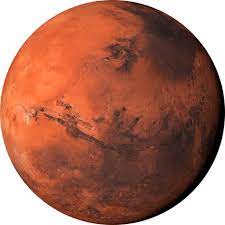The Red Planet: Mars
Mars, often referred to as the “Red Planet,” has captivated the imagination of scientists and space enthusiasts for centuries. This fourth planet from the Sun is a barren, rocky world with a thin atmosphere, but it holds many secrets waiting to be uncovered.
One of the most intriguing features of Mars is its resemblance to Earth in some ways. Scientists have found evidence of liquid water in the past, suggesting that Mars may have once been a more hospitable planet capable of supporting life. The presence of polar ice caps and ancient river valleys further fuels speculation about the planet’s potential for habitability.
Exploration of Mars has been a priority for space agencies around the world. NASA’s rovers, such as Curiosity and Perseverance, have provided valuable data about the Martian surface and geology. These missions have revealed fascinating details about the planet’s history and potential for sustaining microbial life.
In addition to robotic missions, there are plans for crewed missions to Mars in the future. Space agencies and private companies are working on developing technologies that will enable humans to travel to and eventually colonize the Red Planet.
As we continue to study Mars and unlock its mysteries, we gain valuable insights into our own planet’s history and evolution. The exploration of Mars represents a significant step forward in our quest to understand the cosmos and our place within it.
Exploring the Red Planet: 8 Fascinating Insights into Mars
- Mars is the fourth planet from the Sun in our solar system.
- It is often referred to as the ‘Red Planet’ due to its reddish appearance.
- Mars has a thin atmosphere primarily composed of carbon dioxide.
- The surface of Mars is rocky and dusty, with many impact craters.
- Water exists on Mars in the form of ice and there are signs of ancient rivers and lakes.
- Mars has two small moons named Phobos and Deimos.
- Several missions have been sent to explore Mars, including rovers like Curiosity and Perseverance.
- Scientists are interested in Mars as a potential place for future human exploration and even colonization.
Mars is the fourth planet from the Sun in our solar system.
Mars, the fourth planet from the Sun in our solar system, holds a special place in our celestial neighbourhood. With its distinct reddish hue and intriguing features, Mars has long captured the fascination of astronomers and space enthusiasts alike. As we continue to study and explore this enigmatic planet, we uncover valuable insights into the mysteries of our solar system and the potential for life beyond Earth.
It is often referred to as the ‘Red Planet’ due to its reddish appearance.
Mars, known as the ‘Red Planet’, derives its nickname from its distinctive reddish hue, which is caused by iron oxide, or rust, present on its surface. This characteristic feature has fascinated astronomers and stargazers for centuries, adding to the allure and mystery of this intriguing world in our solar system.
Mars has a thin atmosphere primarily composed of carbon dioxide.
Mars, the Red Planet, boasts a thin atmosphere that is predominantly made up of carbon dioxide. This unique composition sets Mars apart from Earth and presents intriguing challenges and opportunities for scientific exploration and understanding.
The surface of Mars is rocky and dusty, with many impact craters.
The surface of Mars is characterised by its rocky and dusty terrain, adorned with numerous impact craters. These craters, remnants of past collisions with asteroids and other celestial bodies, bear witness to the planet’s tumultuous history. The rocky landscape, shaped by aeons of geological processes, provides valuable insights into Mars’ evolution and offers a glimpse into the harsh yet fascinating environment that defines the Red Planet.
Water exists on Mars in the form of ice and there are signs of ancient rivers and lakes.
Water exists on Mars in the form of ice, and intriguing signs of ancient rivers and lakes have been discovered on the Red Planet. These findings suggest that Mars may have once had a more Earth-like environment, with flowing water shaping its landscape over millennia. The presence of water in its various forms raises questions about the planet’s past potential for supporting life and underscores the importance of further exploration to unravel the mysteries of Mars.
Mars has two small moons named Phobos and Deimos.
Mars, the fourth planet from the Sun, is accompanied by two small moons known as Phobos and Deimos. These irregularly shaped satellites orbit Mars at relatively close distances, adding to the unique and mysterious nature of the Red Planet. Phobos and Deimos are thought to be captured asteroids, and their presence in the Martian sky provides a fascinating subject of study for astronomers and planetary scientists alike.
Several missions have been sent to explore Mars, including rovers like Curiosity and Perseverance.
Several missions have been launched to investigate the mysteries of Mars, with robotic explorers such as Curiosity and Perseverance playing a crucial role in expanding our knowledge of the Red Planet. These rovers have provided valuable data about Mars’ geology, atmosphere, and potential for past habitability. Through their discoveries, scientists are piecing together the puzzle of Mars’ history and uncovering clues that could shed light on the planet’s past and present conditions.
Scientists are interested in Mars as a potential place for future human exploration and even colonization.
Scientists are intrigued by Mars as a promising candidate for future human exploration and potential colonization. The Red Planet’s similarities to Earth, such as evidence of water in the past and the presence of polar ice caps, make it an enticing target for further study. Efforts are underway to develop the necessary technologies and strategies that could one day enable humans to visit and potentially establish a permanent presence on Mars, opening up new frontiers in space exploration and advancing our understanding of the universe.

No Responses